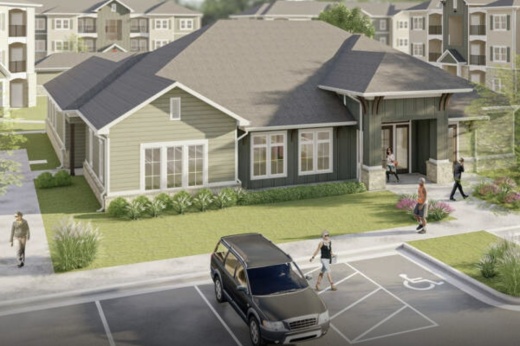The city of San Antonio has started to reveal details on how residents and organizations could take advantage of funds provided by a $150 million bond program designed to increase access to affordable housing and decrease neighborhood displacement.
But some local community activists said they are concerned that the housing bond program may not produce many of the results desired by city officials, neighborhood leaders and affordable housing advocates.
The San Antonio Neighborhood & Housing Services Department held a virtual meeting July 7 and an in-person gathering July 9 at Julia Semmes Public Library about how the local government plans to implement the affordable housing bond, which was part of the $1.2 billion bond package that San Antonio voters passed last May.
Local officials said the bond program will allow the city to embark upon its biggest effort yet to partner with various stakeholders in hopes of increasing San Antonio’s supply of affordable housing, stimulating the economy, and boosting investment in existing older neighborhoods and services that aid unsheltered individuals and those at risk of displacement.
City Chief Housing Officer Mark Carmona said the system for distributing housing bond monies and awarding projects will contain a process involving requests for proposals. He also said it is important that community partners provide adequate input early in the planning process to ensure the housing bond can produce a wide-ranging positive effect.
Carmona also said there is currently a backlog of applicants needing home repair in order to safely stay in their aging house.
“We know that there is a sense of urgency in the community. We know people need help today. We’re doing our very best to provide funds and distribute them out into the community,” Carmona said.
Bond breakdown
Here is how the housing bonds will be disbursed:
- $45 million for rehabilitation and preservation of existing homes that are at risk for demolition and where the household earns 30% to 50% of the area median income, or AMI;
- $40 million for the acquisition, rehabilitation and preservation of existing rental/multifamily housing, which will be redeveloped as public income-based housing for households making up to 30% of the AMI;
- $25 million to support the development of permanent supportive housing for people experiencing homelessness;
- $35 million to support the development of new rental/multifamily housing and acquiring those properties for public income-based housing for households earning up to 50% AMI with a priority for 30% of the AMI; and
- $5 million to support the production of new homes for households making up to 80% of the AMI with a priority on those making 60% and below the AMI.
According to the U.S. Department of Housing and Urban Development, the San Antonio-New Braunfels AMI for a family is $83,500.
Local officials said the city is meeting with an array of committed or potential private- and public-sector community partners, such as community housing development organizations, the San Antonio Housing Trust, the Tier 1 Neighborhood Coalition, the Housing Justice Coalition, Housing First, the San Antonio Housing Authority, and Esperanza Peace and Justice Center.
The city is also meeting with permanent supportive housing providers, certain landlords, single-family rehabilitation contractors, the San Antonio Apartment Association, the Real Estate Council of San Antonio, developers and mission-oriented groups.
City officials said the parameters and framework of the housing bond’s proposal process must prioritize what the city calls “vulnerable populations” as a means of expanding their access to stable housing: families, the LGBTQ community, disabled individuals, older adults and senior citizens, multigenerational families, front-line workers, survivors of domestic violence, veterans, immigrants, youths and adults experiencing homelessness, children and young adults aging out of foster care, and individuals involved in the criminal justice system.
The proposal process must also ensure wide geographic availability to help reduce racial and socioeconomic segregation, city officials said.
To achieve this, proposed housing projects must prioritize income-based housing, established neighborhoods with older housing stock, areas with high rates of eviction and housing at risk of demolition, officials said.
Project proposals must also prioritize strong access to mass transit/public transportation and trail systems as well as regional centers and economic corridors where a variety of employers, health services, neighborhood amenities and cultural assets are plentiful, according to the city.
Additionally, the housing bond process calls for each project to contain energy- and water-efficient features; resilient building and weatherization practices; and affordable, reliable high-speed internet and mobile infrastructure.
Prevention of displacement
City officials said projects that end up receiving bond funding must not cause displacement of residents, and the developer of approved rehabilitation projects should provide a temporary relocation plan for existing property residents at no cost to those tenants.
Additionally, new housing construction projects that receive bond money must complete a displacement impact assessment as part of the proposal process. The city plans to prioritize projects containing extended affordable housing covenants of 20 years or more for homeownership and 40 years or more for rentals.
Homeowners wanting to capitalize on the $45 million in bond money available for fixing and preserving an existing house will have to go through the neighborhood and housing services department’s rehab application process.
City housing bond administrator Jaime Lalley Damron said homeowner rehabilitation and preservation includes minor repairs applied as a follow-up to reported code violations.
Here, each applicant’s needs are assessed and assigned to the appropriate city program. The next homeowner application process window of opportunity will be open Aug. 2-Sept. 19, city officials said.
Four committees will be involved in reviewing and scoring projects proposed for money available in any of the other four bond categories.
According to local officials, each project submitted via the solicitation process will be scored on criteria aligned with parameters of the housing bond committee.
Proposed projects will then be presented to the city’s housing commission and then to the City Council for final consideration. A landlord or prospective builder must be a registered city vendor to access and respond to any published proposal listings.
Damron said when it comes to using housing bond funds to support projects that go through the solicitation process, the city will put greater emphasis on public income-based housing.
“We want to make sure that we are helping to maintain older housing stock,” she said.
Considering inflation, rising interest rates, labor shortages and supply chain problems, it is critical that housing bond funds are quickly put into the pipeline for approved projects, Damron said. But she also warned no projects will be fast-tracked.
“We know there are developments that need funding to meet the requirements to be developed and built, but they do still have to meet our parameters and the framework in order to be considered for our funds,” she said.
Those proposing new affordable housing construction projects must conduct a displacement impact assessment, a process in which all applicants will undergo an initial screening and some applicants will be subject to a secondary screening.
Damron said displacement occurs when a household is forced to involuntarily move from their home because of eviction, demolition, foreclosure, large rent hikes, rising homeownership costs, unlivable conditions, landlord harassment or utility cutoffs.
She also said displacement can occur when costs of living and homeownership increase in a previously affordable neighborhood.
Projects immediately determined to be directly responsible for displacing existing residents on a proposed project site would not be eligible for housing bond money, the city said.
Concerns about bond program
But some attendees of the initial housing bond meeting questioned whether the city’s process will truly realize the aspirations of residents who helped to develop the bond program prior to the May election.
The same attendees, including some community organizers, said they fear displacement will continue and that vulnerable populations will be further marginalized.
Esperanza Center Director Graciela Sanchez said the city must ask prospective developers for more precise data proving that their proposed new housing will not negatively affect residents of an existing neighborhood.
She said rising property values in older parts of town are putting more pressure on some longtime residents who increasingly believe they may no longer be able to afford their home.
“How are we going to deal with that fact, that maybe not tomorrow but in five or 10 years, [displacement] is going to happen?” Sanchez said.
City affordable housing administrator Sara Wamsley called Sanchez’s query a relevant, critical question.
“The hope is that [the displacement impact assessment] helps us to ensure that we’re using data that has a high level of fidelity. We’re not taking [developers] at their word,” Wamsley said.
Sanchez also criticized the city’s plan to have housing bond committee members participate only in an advisory capacity when it comes to reviewing and scoring projects that go through the proposal process.
Sanchez said those housing bond committee members can be better utilized toward helping to directly score projects based on the criteria that they themselves formed while the city was developing the overall $1.2 billion bond package.
“We have a well-grounded mistrust of [city] staff decisions about housing. It just seems like an unnecessary marginalizing of the expertise that the community brings and the passion that the bond committee members brought to this issue,” she said.
Benavidez responded by saying the city could take another look at the composition of the project scoring panel.
Other meeting attendees expressed frustration that the required displacement assessment is, for now, only a city pilot program and not a permanent part of the local government’s housing policy.
Jessica Guerrero, a former chair of the San Antonio Housing Commission, voiced disappointment that the city has not yet implemented a firm, permanent tool meant to prevent displacement despite years of community discussions about displacement in various San Antonio neighborhoods.
“We’re in an ongoing, really urgent housing crisis, and everyone, I think, now acknowledges that displacement has been occurring and continues to occur. So, how is it that, at this point, we’re barely at this [displacement study] being a pilot program?” Guerrero said.
Ian Benavidez, interim deputy director of city neighborhood and housing services, said the city has spent years developing the displacement study, but because nobody knows how exactly it would work to serve as a preventive tool, the study remains a pilot initiative.
“That’s why we’re coming to the public to help us shape what that tool looks like and what our process looks like,” Benavidez said.
Veronica Garcia, the interim director of the neighborhood and housing services department, said this entire process of determining the use of bond funds to support affordable housing is new territory for her and her staff.
“We’re trying to build on previous work, on what other cities have found to be best practices, but we are working in uncharted territory, so all the comments are welcomed. This helps us to further refine our work,” Garcia said.
A second in-person meeting about the housing bond process will take place 5:30-8 p.m. July 12 at St. Philip’s College Veteran’s Outreach Center, 202 Connelly St., Room 208.
According to local officials, the city housing commission will get briefed on the housing bond process at its next regular meeting, set for 11:30 a.m. July 27 at 100 W. Houston St.
The city plans to formally release a request for proposals in August, the same month when the City Council will examine the project scoring criteria. Proposals will be due in October and undergo scoring and reviews that same month.
The scored proposals will undergo reviews by the housing commission in November and be considered for final council action in December.





